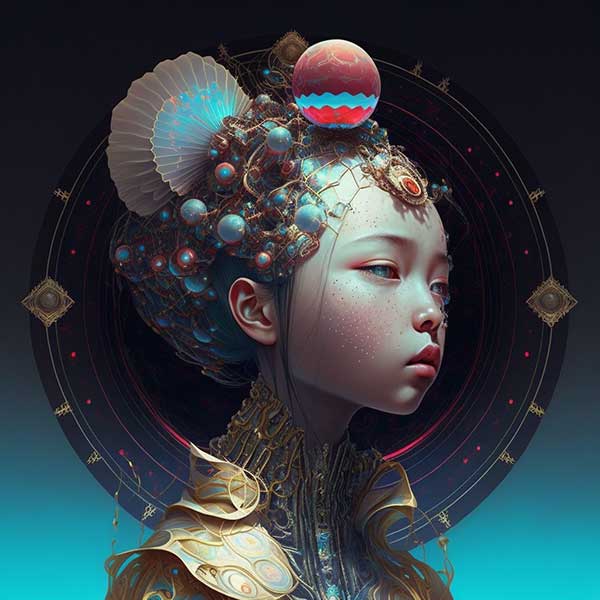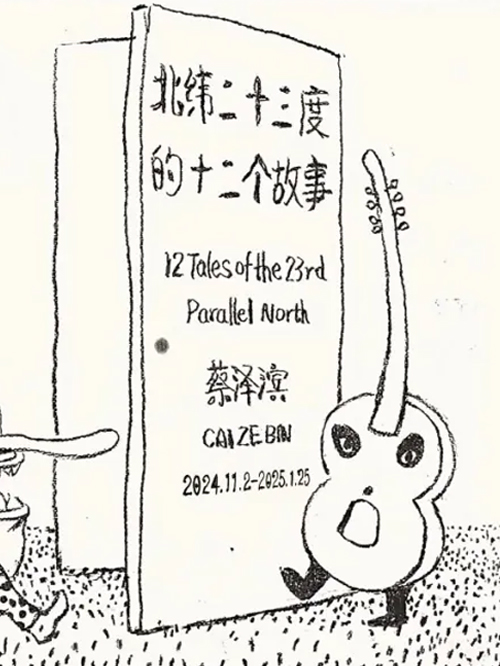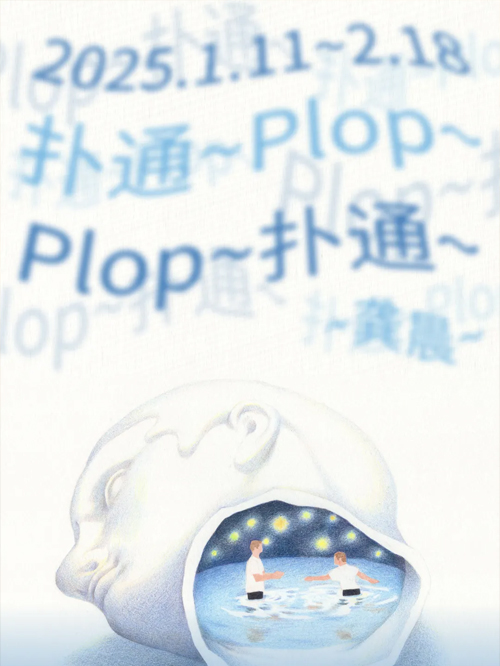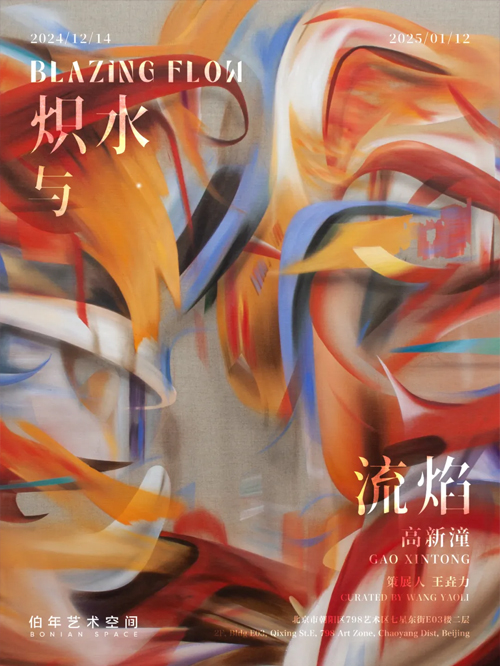胶囊上海荣幸推出艺术家蔡泽滨在画廊的第三次个展“北纬二十三度的十二个故事”。展览包含艺术家最新创作的架上作品,展现出艺术家在探索创作方法和语言时的多维形塑,以及视觉语言构造中的丰富内涵。
展览标题中的北纬二十三度,泛指着蔡泽滨居住和生活的城市——汕头所在的区域方位,他以十二件作品记录了由黄昏到黑夜的多个瞬间。此前持续三年的“画板人”系列暂告一段落,但围绕着蔡泽滨近两年以居住地为中心的生活经验,他基于自我主体意识——一个画家的身份定位,作为画面的见证者与创作者,带来一个万物皆具生命的神秘世界。
他创作的灵感来源从未脱离过日常生活,就像《尤利西斯》中的人物不停地在城市中游走、交谈,一系列荒诞想象在心灵深处流淌。蔡泽滨以最切身的经验和感受连接起无限联想,所创造出的画面既是原初的(originary),又是记忆的(memorial)。当现实性的各种知觉对象充斥在眼前,他所积累的图像意识结构开始延伸出更为虚无性的、与当前无关的对象,这很大程度上得益于他对环境的非再现性处理。因而在蔡泽滨的“故事”中很难找到与现实对应的时空,但折纸的空间折叠感和极薄的质感以躺倒的人形反映着疲惫而无力的心境,卡夫卡的《变形记》、奥迪隆·雷东(Odilon Redon)的《哭泣蜘蛛》与《千与千寻》中锅炉爷爷的外形,唤起的是造型上对比感完美的例证,随着蔡泽滨所塑造的形象表情消失,画面的整体面貌变得平静。

Cai Zebin 蔡泽滨 | The Story of the Shadow 阴影的故事 | 2023 | acrylic on canvas 布面丙烯 | 153.5 x 133 cm
无情绪的表达也体现于局部面孔器官的缺失处理,比如《你好和哈喽》中消失的嘴部、《阴影的故事》《自画像——变形记》中仅以孔洞代替眼睛,以及《微光》中仿似昆虫形象的桌面。与此同时,在一些微妙的曲线与夸张放大的眼睛搭配下,《午夜困惑》中人物的表情显然充满困惑、《侦探的问候》亦呈现出某些疑问,《大佬之歌》中更添几分戏谑……
蔡泽滨常将面部表情与部分躯体相连,完整的鱼变化成一个魔法师的面部(《鱼的魔法师》),《长鼻子画家》《舞蹈幽灵》中的“变异体”等,而前述的众多作品中也同样有相似手法的嫁接。他让这些形象巨大化到不可忽视的地步,延伸出的变形的躯干牵引着观众的视角找寻更多细节,仿佛这些主角是画面的中心枢纽,连接着艺术家埋藏的种种蛛丝马迹。阿尔贝托·贾科梅蒂(Alberto Giacometti)的雕塑、维克多·布罗纳(Victor Brauner)的绘画、格兰特·伍德(Grant Wood)的风景,以及蔡泽滨自己过往创作中的元素都被他编织到了作品的各个角落。
对于自己感兴趣的经典艺术家创作,蔡泽滨会多次临摹,这种方式颇似中国绘画中的“师古”,但他所着力的是如何在实践中更加接近艺术家在绘画中的灵感与神韵。众多练习的手稿记录了蔡泽滨不断理解和转化的过程,同样的思路也可见于马格利特的《透视Ⅱ:马奈的阳台习作》如何脱胎于马奈的《阳台》。从小的部件到大作品的组织方式绝非雷德侯在《万物》中提出以生产为目的的模件化概念,因为后者并未经历复杂的思考和转换。塞缪尔·贝克特(Samuel Beckett)的《呼吸》、柳德米拉·彼得鲁舍夫斯卡娅(Lyudmila Petrushev)的《迷宫》以及潮汕地区的文化活动,从文本和民俗中幻化的想象嫁接了艺术家的长期思考,恰恰是在绘画语言的重构和视觉传达中体现出创作者的主体性精神。
除了将身体局部重构外,将日常景观具象拟人的方式在蔡泽滨的创作中也不鲜见。夜间的喷泉雕塑在日月交叠的神秘氛围中化为伤感的哭泣之人,充满肌理的马蜂窝如雕塑,却又延伸出有生机的肢体。艺术家的叙事以象征主义方法去结合想象的过程,在他的每一本艺术家书中娓娓道来,展现出他对知识和艺术态度的追求。每一件作品中的形象犹如艺术家从物到像的自我比照,也是他者的建构。“尽可能地简单,但不能简化”蔡泽滨将非现实的部分隐藏于无数现实碎片中,正如海报中所呈现的,打开的书卷中,每一页都是可翻转的任意门。
撰文:孟宪晖
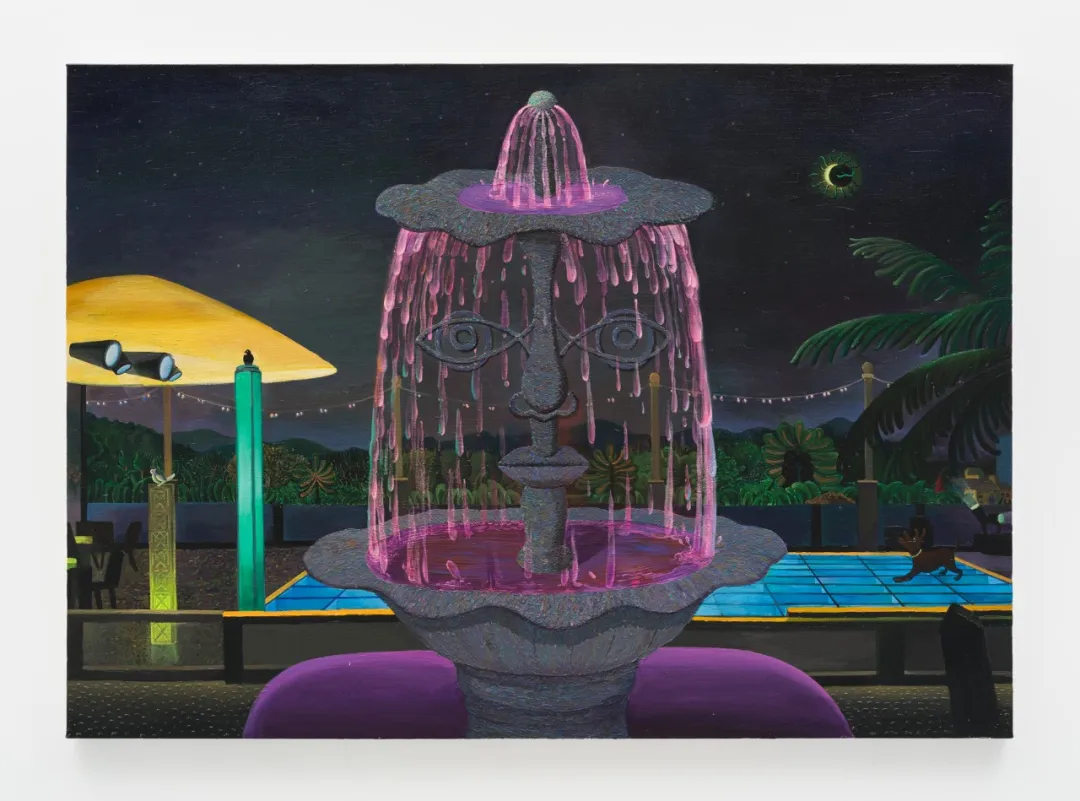
Cai Zebin 蔡泽滨 | Gaze From the Fountain 喷泉的凝视 | 2023-2024 | acrylic on canvas 布面丙烯 | 154.5 x 216.5 cm
Capsule Shanghai is honored to present artist Cai Zebin’s third solo exhibition at the gallery, 12 Tales of the 23rd Parallel North. The exhibition showcases the artist’s recent paintings, unveiling his multifaceted exploration of creative approaches and language, along with the rich implications within his visual compositions.
“The 23rd Parallel North” in the exhibition title refers to the region of Shantou where the artist lives and works. In the twelve paintings on view, he captures moments from dusk to night. Temporarily shifting away from the “palette person” series that had been the core of his practice for three years, Cai, over the last two years, redirects his exploration to life around his hometown. Starting from the self-awareness of his identity as a painter, the artist acts as both the witness and the creator of the portrayed scenes, constructing a mystical world where everything is imbued with life and soul.
Cai's inspirations never stray far from everyday life. Streams of fantastical imaginings flow in his mind like characters in Ulysses that wander and converse in the city. Stringing together the imaginings through first-hand experiences and feelings, he creates images that are both originary and memorial. When objects from reality enter his view, his visual sensitivity breeds illusory beings detached from reality - a process deeply influenced by his non-representational approach towards the surroundings. It is therefore challenging to find in his “tales” a direct correspondence with real time and space. However, the lying origami’s flimsy texture and sense of spatial folding suggest exhaustion and powerlessness. Kafka’s The Metamorphosis, Odilon Redon’s The Crying Spider, and Kamaji (the Boiler Geezer) in Spirited Away by Miyazaki Hayao all inspire a perfect sense of formal contrast. As the figures’ facial expressions fade, an overall serenity emerges from the paintings.
This emotionlessness is also evident in the omission of facial features, such as the absence of mouths in Ni Hao and Hello, the use of simple holes in lieu of eyes in The Story of the Shadow and Self-portrait - Metamorphosis, and the insect-shaped table in Glimmer. On the other hand, when exaggerated eyes are paired with subtle curves, the protagonists in Confusion at Midnight look adequately bemused; Greetings of the Detective presents certain questions; The Song of the Big Shot has an undertone of humor and wit.
Cai frequently merges facial expressions with body parts, such as the fish in place of the magician’s face (Ichthyic Magician), and the mutants in The Painter With a Long Nose and Dancing Phantom, among other examples of hybridization in his works. The figures are enlarged to a remarkable scale, from which grows distorted limbs that direct the viewer’s gaze to a maze of details. The protagonists serve as the central junction of the painted image, connecting myriads of hidden clues. Elements of Alberto Giacometti's sculptures, Victor Brauner's paintings, Grant Wood's landscapes, and elements from Cai’s previous works are ingeniously woven into the paintings.
The artist often replicates classic works of admired masters as a way to study them, similar to the practice of “learning from the ancients” (shī gǔ,师古) in traditional Chinese painting. However, his focus is on capturing the spirit and essence of the classic works. The vast collection of Cai’s manuscripts attests to an evolving process of comprehension and transformation - the same process through which Magritte’s Perspective II: Manet’s Balcony Study was born out of Manet’s The Balcony. Cai’s construction of small components into large compositions differs fundamentally from Lothar Ledderose's notion of module for the purpose of mass production, as the latter does not require complex thinking or transformation. From Breath by Samuel Beckett, The Maze (published in the US under the title There Once Lived a Woman Who Tried to Kill Her Neighbor's Baby: Scary Fairy Tales) by Lyudmila Petrushevskaya, to cultural activities from the region of Chaoshan, imaginations conjured from literature and folk customs are implanted into the artist’s thinking. It is through the reconstruction of painterly vocabulary and visual communication that the artist’s subjectivity is revealed.
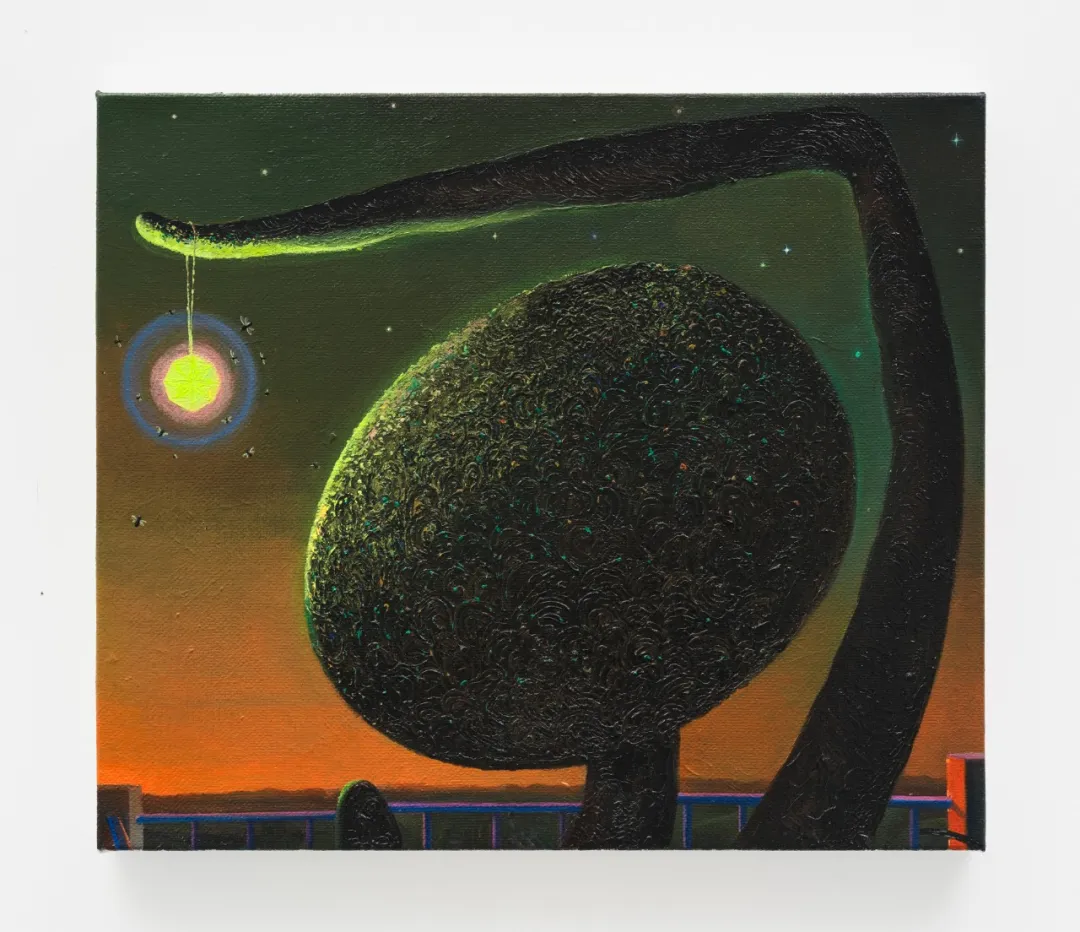
Cai Zebin 蔡泽滨 | The Miracle of the Wasp Nest 马蜂窝的奇迹 | 2023-2024 | acrylic on canvas 布面丙烯 | 69.5 x 81 cm
In addition to juxtaposing body parts, Cai often anthropomorphizes everyday scenes. The fountain statue morphs into a crying person in a mystical concurrence of sun and moon. The richly textured wasp nest, while resembling a sculpture, grows limbs brimming with vitality. The artist infuses imagination into symbolism to form a narrative – a process that he unravels in a series of artist books, shedding light on his pursuit of knowledge and artistic vision. Each figure in his painting is both a reflection of the Self and a construct of the Other, embodying the transformation from object to image.
“Concise but not simplistic.” Cai Zebin conceals the surreal within fragments of reality, like the open book depicted in the exhibition’s poster, where each page is a portal to endless possibilities.
Text by Meng Xianhui

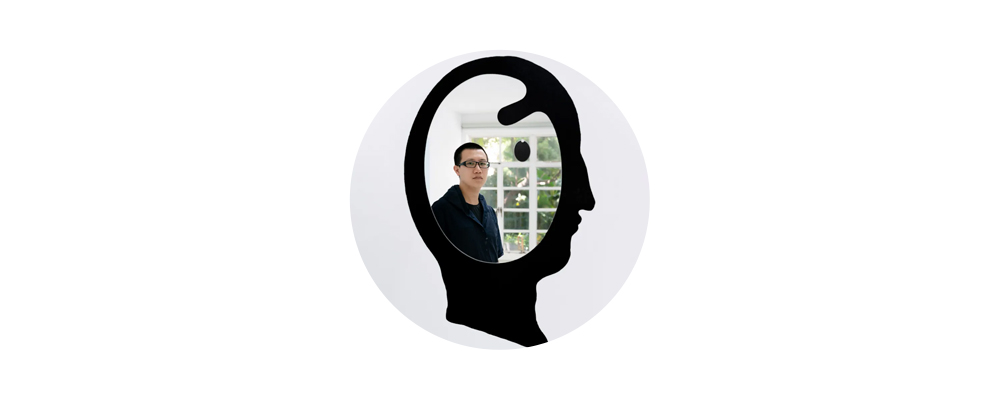
蔡泽滨(出生于1988年,广东省汕头市)现生活工作于汕头,2012年毕业于广州美术学院油画系。
他的绘画中天马行空的场景常常来源于他对艺术家和⽂学的知识,他重新解读已有的主题和意象,进⽽审视绘画和艺术创作的过程本身。
主要个展包括:“北纬二十三度的十二个故事”,胶囊上海,中国上海(2024);"从佩雷尔街到南方哥特",香港中文大学(深圳)TC101 SPACE,中国深圳(2022);夜游,Artissima,意大利都灵(2022)"Hello, Self-portrait",L21画廊,西班牙巴利阿里群岛(2021);"旧地重游佩雷尔街2号",胶囊上海,中国上海(2020);"拉瓦尔",巴黎国际展,法国巴黎(2019);"防守",胶囊上海,中国上海 (2018);"橄榄",NUOART画廊,中国北京 (2015)。曾参与群展:“共贯与多元”,中国美术馆,中国北京(2024);“这里,哪里,那里”,阿尔敏莱希,中国上海(2024);" X PINK 101 ",X美术馆,中国北京(2023);“贮藏”,麦勒画廊,中国北京(2022);"Universes 5", The Hole, 美国纽约 (2022)";"Salon de Peinture",阿尔敏·莱希,美国纽约(2021);"F#%k U & ur DisNey",Super Dakota,比利时布鲁塞尔(2021);12 Artists, Harper's 画廊, 美国纽约 (2020); "隐喻现实",阿尔敏·莱希,中国上海(2020);"珠江夜游",广东美术馆,中国广州(2019);"城市无界",静安雕塑公园,中国上海(2018);"门闩:肖像画的隐晦目的",C龙口空间,中国北京(2017);"□",A+亚洲艺术中心,中国台湾台北 (2016);"腹地计划",时代美术馆,中国广州 (2015)等。
蔡泽滨的作品也曾多次受到国内外艺术杂志的报道,包括《ArtMaze Magazine》 《Artforum》《艺术界》《艺术碎片》《艺术汇》《亞太藝術雜誌》和Contemporary Art Daily线上平台期刊等。
Cai Zebin (b. 1988) is a visual artist based in Shantou, Guangdong province in Southern China. He graduated from Guangzhou Academy of Fine Arts in 2012.
The often whimsical and fantastic scenes in Cai Zebin's paintings draw inspiration from his extensive knowledge of art history and literature, reinterpreting existing motifs and devices to evaluate the process of painting and, ultimately, making art.
Selected solo includes: 12 Tales of the 23rd Parallel North, Capsule Shanghai, Shanghai, China (2024); From rue Perrel to Southern Gothic, TC101 SPACE, The Chinese University of Hong Kong (Shenzhen), China (2022); Hello, Self-portrait, L21, Islas Baleares, Spain (2021); A Revisit at 2 bis rue Perrel, Capsule Shanghai, Shanghai, China (2020); Laval, Paris Internationale, Paris, France (2019); The Defense, Capsule Shanghai, Shanghai, China (2018); Olive, NUOART Gallery, Beijing, China (2015). He has participated in the following group shows: One and All, National Art Museum of China, Beijing, China (2024); Here, Where, There?, Almine Rech, Shanghai, China (2024); X PINK 101, X Museum, Beijing, China (2023); A Place for Concealment, curated by Yang Zi, Galerie Urs Meile, Beijing, China (2022); Spring Antidote, curated by Capsule Shanghai, Blanc Art Space, Beijing, China (2022); Salon de Peinture, Almine Rech, New York, USA (2021); F#%k U & ur DisNey, Super Dakota, Brussels, Belgium (2021); 12 Artists, Harper's Gallery, New York, USA (2020); Metaphorical Reality, Almine Rech, Shanghai, China (2020); Exhibition of Young Power, Guangdong Museum of Art, Guangzhou, China (2020); Night Tour of the Pearl River, Guangdong Museum of Art, Guangzhou, China (2019) among others.
Cai Zebin's work was featured on Artmag, Artforum, Leap, Artshard, Art Frontier, ArtAsiaPacific and Contemporary Art Daily.
